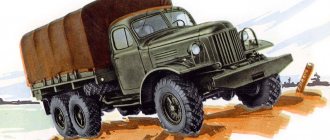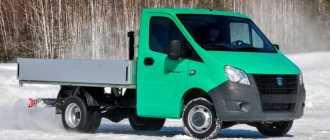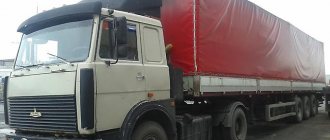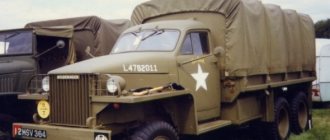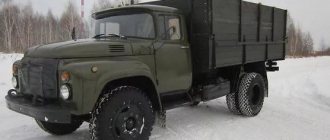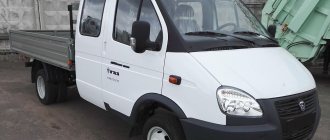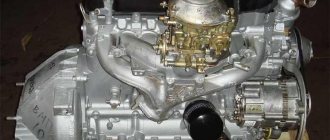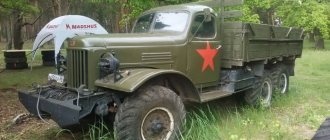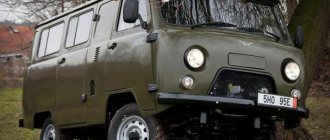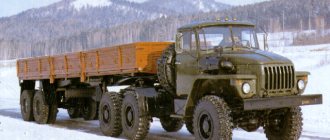MAZ-64229 truck tractors belong to the popular SuperMAZ family. Despite their widespread prevalence in all fraternal republics, they, oddly enough, were deprived of the attention of the press. But these vehicles can rightfully be called the best trucks for intercity transportation among all those produced in the USSR! Everything about the history of MAZ-64229 and its technical features is in this publication.
The MAZ-64229 truck is a truck tractor with a six-by-four wheel arrangement. This model of the Minsk Automobile Plant was created for long-distance cargo transportation and became the “successor” of the MAZ-504 and MAZ-515 vehicles. The MAZ-64229 truck tractor, from the new MAZ-6422 family, was launched into mass production in 1987. The main changes affected the engine, which became more powerful and equipped with a turbocharging system. However, many other modifications and improvements were made. Including those related to the equipment of the cabin, increasing the level of driver comfort - a noticeable step forward has been made here.
History of MAZ – Home – About MAZ
The Minsk Automobile Plant today produces road trains for international and intercity transportation of goods, on-board general transport vehicles, dump trucks and dump truck trains, timber trucks, all-wheel drive vehicles and chassis vehicles.
From 1947 to 1965, the plant produced well-known cars of the MAZ-200 family, and since 1966 it completely switched to the production of cars of the MAZ-500 family. These cars were a significant improvement over those previously produced. In their design, for the first time in the practice of the domestic automotive industry, the design of a tilting cab above the engine was used, which made it possible to increase the vehicle's carrying capacity, its maneuverability, and improve the driver's working conditions. In the MAZ-500 family of vehicles, a high degree of unification of components and parts has been achieved.
Since 1971, the plant began to produce modernized cars of the MAZ-500A family instead of cars of the MAZ-500 family. And since 1978, the plant began production of a new, improved family of MAZ-5335 vehicles, which meet international requirements in many respects.
Based on the MAZ-5335 vehicle, the plant produced a family of heavy-duty vehicles for various purposes: MAZ-5335 (Fig. 1) and MAZ-516B (Fig. 2) onboard vehicles, MAZ-5549 dump trucks (Fig. 3), MAZ-5549 truck tractors 5429 (Fig. 4), MAZ-5430 and MAZ-504V (modernized) (Fig. 5), which, compared to cars of the MAZ-500A family, have better technical and operational qualities.
In 1983, the plant switched to serial production of cars and long-haul road trains of a new generation, the base models of which were the two- and three-axle tractors MAZ-5432 and MAZ-6422, which in terms of technical, operational, economic and aesthetic indicators corresponded to the level of the best foreign analogues.
The three-axle truck tractor MAZ-64227 (Fig. 6) with drive to the middle and rear axle and the two-axle truck tractor MAZ-54322 (Fig. 7) with drive to the rear axle are maximally unified. The main semi-trailer for the MAZ-64227 tractor is the MAZ-9398, and for the MAZ-54322 tractor is the MAZ-9397 semi-trailer. The high traction and dynamic qualities of the new MAZ family vehicles and good fuel efficiency indicators were achieved thanks to the installation of YaMZ-238PM and YaMZ-238FM turbocharged engines, an 8-speed gearbox, rational choice of drive axle ratios, and improved aerodynamic qualities. Their further improvement was the modernized truck tractors MAZ-64229 and MAZ-54323.
The beginning of the 90s was marked by the creation of new models of two-axle and three-axle truck tractors MAZ-54321 and MAZ-64221, equipped with engines from the Yaroslavl and Tutaevsky Motor Plants of the German company MAN.
Currently, the plant produces European-class road trains consisting of two-axle truck tractors MAZ-54326 and MAZ-54327 and a three-axle semi-trailer MAZ-9758. These road trains meet European requirements and safety standards, are equipped with anti-lock and anti-slip braking systems, a maximum speed limit system, modern lighting devices, and rear air suspension with an electronic control system. In addition, the MAZ-54326 is equipped with an environmentally friendly and economical MAN engine.
In parallel with the fifth generation MAZs, the production of new generation vehicles has begun, fully meeting European requirements for vehicles of the same class. In two- and three-axle vehicles of the new model range MAZ-5440 (Fig. 8) and MAZ-6430 (Fig. 9) with a high technical resource, the use of modern engines from Western European, American and Russian manufacturers is provided. In addition to MAN engines, Detroit Diesel, Perkins and Cummins engines are also adapted for these tractors. All engines comply with Euro-2 standards in terms of exhaust gas toxicity.
The vehicles are equipped with a highly comfortable cabin of increased volume, two berths, drive axles of increased durability with optimized gear ratios (depending on engine power and vehicle purpose), air suspension, braking system, frame with a new design of cross members, etc. The new tractors are equipped with on-board diagnostic equipment , anti-lock and anti-slip braking systems, electronically controlled air suspension, which corresponds to the best foreign analogues.
The modern three-axle flatbed vehicle MAZ-6301 with a 6×2 wheel arrangement with a load capacity of 14 tons with a rear additional suspended axle is designed to work as part of a road train with a total weight of 40 tons.
Of specialized vehicles, the production of new models of dump trucks has been launched: the three-axle 6×4 MAZ-5516 (Fig. 10) and, based on it, the all-wheel drive 6×6 MAZ-55165, as well as the MAZ-64228 dump truck with the MAZ- semi-trailer 9506 (Fig. 11).
The MAZ-6317 all-wheel drive cross-country vehicle (Fig. 12) with a 6x6 platform wheel arrangement and, on its basis, the MAZ-6425 truck tractor are designed for off-road cargo transportation in the conditions of the Far North and Siberia. The design of these cars in terms of technical level and equipment corresponds to the best world examples of this class.
Based on the MAZ-6317 vehicles, a commercial modification of the MAZ-63171 vehicle is produced (Fig. 13) with a 6x6 wheel arrangement with a dual-pitch tire and a tarpaulin side platform.
Today, the plant's products include dozens of models and modifications of two- and three-axle truck tractors, trucks, dump trucks, timber carriers, chassis for equipment with cranes and drilling rigs, tanks, fuel tankers, municipal and road equipment and meet the requirements of the modern market.
Modern designs of vehicles of the MAZ family are as unified as possible, so the issues of maintenance and repair of the basic models of the two-axle onboard vehicle MAZ-5335 and the three-axle truck tractor MAZ-64227 as general-purpose vehicles are described in detail here.
For other models and modifications of cars, only the features of maintenance and repair of units, components and parts other than the base models are outlined.
history of the Minsk Automobile Plant
maz-auto.info
Modification "B"
What does the MAZ-515B truck tractor look like? The reader can see a photo of a Soviet truck below.
The differences between this model and the basic one are immediately noticeable. First, this truck gets a different grille. The same one was installed on the updated “tadpole”. The radiator grille has become plastic. The head optics have also changed. Thus, the headlights became more rectangular and were moved to a metal bumper. Also in the bumper there are fog lights and two towing “fangs”. The side lights are still located on the roof. The shape of the mirrors has also not changed. Among other differences of this modification, it is worth noting the new fuel tank. So, instead of two small ones, modification “B” had a large tank installed on the left side of the frame. This truck tractor has been mass-produced since 1977.
MAZ transmission
This vehicle is equipped with an eight-speed manual transmission with mechanical remote control and overdrive. Synchronizers are present in second, third, fourth and fifth gears. The input shaft with gear is installed in the gearbox housing on a ball bearing. The intermediate shaft is also located here. The rear bearing housing is closed using a cast iron cover.
The reverse and first gear gears are cut on the shaft itself. And the gears of other speeds (starting from the second and ending with the fifth) are mounted on the shaft with keys. There is a damper on the intermediate shaft drive gear. This reduces vibrations transmitted from the engine flywheel. Also, the need to install this damper is due to the insufficient uniformity of operation of the diesel engine. The ring gear is made separately from the hub and is connected to it by means of cylindrical springs in a total of six pieces. The vibrations that are transmitted to the crown are reduced due to the deformation of the springs. There is an axle on the side between the secondary shaft of the MAZ gearbox and the intermediate ones. It is equipped with a reverse intermediate gear (double). The front gear meshes with the first gear of the intermediate shaft. And the rear one interacts when reverse gear is engaged.
At the front, the secondary shaft is mounted on a roller bearing. The rear end is located in the crankcase and is mounted on a ball bearing. At the end of the shaft that protrudes outward there is a universal joint flange and a speedometer drive gear.
Also installed on the secondary shaft are the gears of the second, third and fifth acceleration gears. A steel plain bearing is used here. To prevent the gears from moving in the longitudinal direction, special thrust rings are used. All three parts are distinguished by oblique teeth. They engage with the intermediate shaft gears. The ends have a conical surface. There are synchronizers between the gears, which ensure silent and smooth switching of speeds. The synchronizer itself consists of a coupling that is installed on the shaft or on its splines (depending on whether it is a front or rear synchronizer). The element also includes conical rings made of bronze. The synchronizer housing is connected via ball clamps to the coupling. A ring is attached to the outside using pins. Its groove includes a shift fork.
Car device
The manufactured MAZ 6303 vehicles use a classic design scheme, where the frame, which is made of durable materials, is considered the supporting element for the body, power plant, and suspension. This allows it to withstand even harsh conditions of use. But there are also vulnerable places, which are considered to be crossbars and linings. At the same time, it is easy to replace them if necessary; for this you need to first order the part through any catalog. The middle bridge itself has a complex structure, due to the fact that it is a connecting element for the main components.
The YaMZ 238 diesel unit of various modifications is used as a power plant. Which version is installed on the truck is determined by its intended purpose. Thus, the line of these engines includes 8-cylinder engines producing power of 170-400 hp. With. The working volume of such a power plant is 14.86 liters.
The cab body can be shortened, as well as full-size, including 2 berths.
MAZ 6303 is a universal chassis that can be equipped with various types of bodies. The most popular option is the truck. The model was produced in the 90s and has since received many improvements and modifications.
Cabin
The machines are equipped with large and small cabins. The first is installed on long-haul trucks, truck tractors, and vehicles for transporting goods over long distances. The high-capacity cabin has two berths. The small cabin is installed on special vehicles, as well as trucks for transporting goods over short distances.
The MAZ-6303 model has a cabover layout; to gain access to the engine, the driver needs to tilt the cab forward. The process is facilitated by the presence of a hydraulic system.
The car has a fairly roomy and spacious interior, which provides excellent visibility of the road space, the interior is not susceptible to vibrations and noise penetration. Thermal insulation is also excellent. The disadvantages of the truck's interior include poor quality finishing materials and imperfect build quality.
The standard interior configuration includes driver and passenger sprung seats, seat belts, main and auxiliary heaters. It is quite easy to turn the steering wheel and press the pedals, which allows you to work on the truck for a long time without getting tired.
Attention! The design of the MAZ-6303 truck implies the presence of a heating valve under the cab, which makes the process of turning on the heaters quite inconvenient - the driver needs to get out of the truck, raise the cab, and unscrew the valve to allow heat to enter the cabin.
Chernobyl MAZ-504V | mpark.pro history
The Chernobyl disaster is 30 years old. Three decades have passed since the fourth power unit of the Chernobyl Nuclear Power Plant exploded on April 26, 1986. The consequences are still being felt today. And then it was a shock even for such a superpower as the USSR. But a lot of work was done to reduce the consequences of the accident, despite the shock.
All possible resources were involved - science, army, industry. All industry. Including automobile. Including MAZ. Our story is about the special MAZ-504V truck tractor, created in Minsk to eliminate the consequences of the Chernobyl accident.
I learned that such a special MAZ existed at all in 2009, thanks to a collectible model in 1/43 scale, which was produced by the Minsk workshop Ad Modum.
01. However, this particular model was made “based on interviews with eyewitnesses,” that is, from words, without visual materials. At that time, it was believed that photographs of the Chernobyl MAZ either did not exist or had not been preserved. In any case, Ad Modum’s attempt to preserve the memory of the unique MAZ, at least in this form, deserves great respect.
Naturally, as in all such cases (no one has yet managed to create an accurate model “from words”), there was no need to talk about historical accuracy. But the theme of “Chernobyl MAZ” itself touched the soul. The task of finding information on a genuine prototype became something of a matter of honor for me. And... He who seeks will always find. Unique archival photographs were eventually discovered.
02. The authentic Chernobyl MAZ looked like this:
03. The basis was taken from the standard “conveyor” truck tractor MAZ-504V, which was subjected to anti-radiation modifications and repainted in the military color “Protective ML-12”.
04. The factory emblem was not installed. There is no longer any need for the right windshield wiper. All the internal lining was “thrown out” of the cabin and a capsule made of sheet lead 10 mm thick was inserted into the driver’s seat. The driver entered the capsule from the passenger door through a sealed hatch.
05. A military filter-ventilation unit FVUA-100N-24 was installed on the roof. It provided excess pressure inside the capsule and prevented radioactive dust from getting inside.
06. “View” from the capsule was provided through a small window in the armor. A plate (probably crystal) measuring 400x400 mm was used. The thickness of the glass was an impressive 100 mm.
07. The lead capsule turned out to be very heavy. Its own weight was more than 3 tons. Naturally, the car tilted on its side. Even additional sheets added to the springs did not help.
08. Due to deteriorated (virtually disappeared) visibility, the system of brackets for rear-view mirrors was completely changed.
Thus, the Chernobyl MAZ had not only internal, but also significant external differences from the serial MAZ-504V saddle trucks. All these nuances are very important for modelers, so...
09. Based on the found archival photographs, the Ad Modum workshop made the correct collectible model.
10. Even the seating position of the cabin was respected. Well done.
11. No wonder “Ad modum” translated from Latin means “According to the model.” The Ad Modum workshop has always been famous for its meticulous attention to detail.
12. A worthy prototype has acquired a worthy scale collector's copy.
Remembering the MAZ special vehicle, one cannot help but mention the fact that other enterprises also built equipment for the liquidators of the Chernobyl accident. This is what our Remarque is about.
Remark by M-Park
The Ministry of Medium Engineering, which owned a large number of enterprises, including the Chkalov Automobile Repair Plant, which produced Tajikistan buses, was responsible for nuclear energy in the USSR. It is not surprising that it was ChAZ, subordinate to the Ministry of Medium Machine Building, that was the first to build a special vehicle for Chernobyl.
13. On an emergency basis, several batches of 20-seater Tajikistan-3205 special buses with lead panels in the body trim and an air filtration system were made in Chkalovsk (aka the closed city of Leninabad-30). They were immediately nicknamed “lead beads.”
Photo from the collection of Denis DEMENTYEV
All 50-odd examples built had a modified design of passenger seats, in which you had to sit almost on the floor itself. Only 15 days passed from the moment the order was received to the shipment of the first batch of 10 “pig buses”: in June 1986, they were already used by the liquidators who were building the “sarcophagus”.
The exact dates on which the Chernobyl task was completed by the Kremenchug Automobile Plant are also known. The first copy of the special KrAZ-256B1-030 vehicle left the gates of the experimental workshop on July 10, 1986.
14. At first, KrAZ experimented with a lead capsule inserted into a standard cab.
15. Later they abandoned the cabin and began to use only the capsule. In total, 18 KrAZ-256B1-030 liquidation dump trucks were built in Kremenchug. The last samples were collected on July 27.
ZIL also had a “Chernobyl” mission. In Moscow, special versions of the ZIL-130 trucks were built with a protective capsule in the cab and a FVU on the roof. On the basis of these chassis, watering and washing machines were made to treat contaminated areas with a disinfectant solution.
It is also known that special large “lead buses” for the Chernobyl Nuclear Power Plant were built by the Lviv Bus Plant.
16. A photograph of a group of “Chernobyl MAZs” near the Experimental Workshop No. 1 of the Minsk Automobile Plant is dated August 1, 1986. This means that MAZs appeared in the vicinity of Pripyat immediately after KrAZs. Presumably the special MAZs were intended to work in tandem with panel semi-trailers.
The exact number of special MAZ-504V truck tractors manufactured for the Chernobyl Nuclear Power Plant is not yet known. According to some sources - four, according to others - six copies.
The Minsk Automobile Plant worked on the Chernobyl topic as quickly as possible and completed the task. This was the only such experience. We hope that neither MAZ nor anyone else will ever need it again.
mpark.pro
Specifications
So, let's look at the technical characteristics of the MAZ-515. A diesel engine from the Yaroslavl Motor Plant was used as the power unit for this truck. It became the YaMZ-238N unit. What kind of motor is this? This is a V-shaped, eight-cylinder engine with a displacement of 14860 cubic centimeters. The cylinder diameter is 130 millimeters. And the piston stroke is 140 millimeters. The rated power of the Yaroslavl engine is 300 horsepower or 220.5 kW. Torque – 1088 Nm at one and a half thousand rpm. In this case, the minimum crankshaft rotation speed is 550 rpm at idle. Maximum frequency – 2275 rpm.
Despite its weight, the car can accelerate to 85 kilometers per hour. At the same time, fuel consumption is 30 liters per 100 kilometers. Of course, this figure could differ in real conditions, but it was still less than that of KamAZ, which was released a little later.
